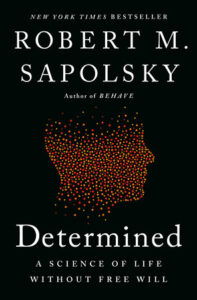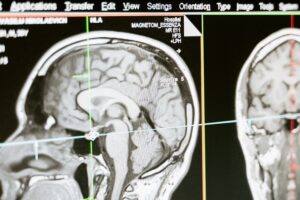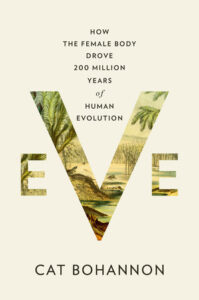calsfoundation@cals.org
Book Flood: Exploring Free Will and Memory
Some years back, my wife read about the Icelandic tradition of Jolabokaflod, which translates literally as “Christmas book flood” and entails giving and receiving new books on Christmas Eve. She liked the idea of this, and so each year we go to our local independently owned bookstore a few days before Christmas and try to find a book for each other. This past year, with Christmas occurring on a Monday, we would have the whole weekend before us for potential reading, and so she said, “We could get each other two books, just to make sure we have enough.” It does not take much to talk me into buying even more books.

My two this time around were Robert Sapolsky’s Determined: A Science of Life without Free Will and Cat Bohannon’s Eve: How the Female Body Drove 200 Million Years of Evolution, two works published this year. Bohannon’s book was new to me, but I had been looking forward to Sapolsky’s for some months, having greatly enjoyed his 2017 book Behave: The Biology of Humans at Our Best and Worst.
Sapolsky’s thesis is this: Although we may possess a subjective experience of free will, and thus can seemingly choose from an array of options (whether to have ham or turkey for lunch, whether to grow up to be president or a plumber), the fact is that “when you behave in a particular way, which is to say when your brain has generated a particular behavior, it is because of the determinism that came just before, which was caused by the determinism just before that, and before that, all the way down.” That is, our behavior is the result of the present state of our brain, which is the result of earlier states of our brain, which is the result of the environment in which we were raised (including everything from the culture in which we marinated to any particular chemicals to which we were exposed), in addition to the genes we inherited and how those genes are expressed.
It’s turtles all the way down. There’s no floor of free will upon which any of those turtles stand. Everything, our very behavior, was determined by what came beforehand, both in terms of our genetic inheritance and the environments in which we by circumstance have found ourselves. We are, Sapolsky writes, “nothing more or less than the sum of that which we could not control—our biology, our environments, their interactions.”
Many people will be offended, even horrified, by such a worldview. After all, attacking the idea of free will rather entails an attack upon the very idea of individualized selfhood. But is not selfhood already contextual? You might be a Missionary Baptist living here in central Arkansas, but you can imagine that, having been born in Saudi Arabia, you would not have been raised as such, and the chances that you would have even been exposed to Baptist ideology approach nil. Likewise, the language we are raised to speak shapes the ideas to which we can give expression and the categories we impose upon the world, while our broader culture shapes everything from whether we exhibit greater individualistic or collectivistic behaviors.
And actually, our culture shapes our very brains. As Sapolsky recounts, the human brain exhibits remarkable plasticity up to our teenage years, when suddenly certain neural connections start to be culled. This is why it’s harder to learn a new language, and exhibit any fluency, after about age twelve, because the brain, having gotten something of a handle on what is expected of it, does like a student having finally chosen a major and focuses upon what it knows, due to experience, will be required of it.
All of this leaves relatively little room for free will. Moreover, the absence of free will means that we cannot assign specific moral blame to people for their actions. As Sapolsky writes:
There is no justifiable “deserve.” The only possible moral conclusion is that you are no more entitled to have your needs and desires met than is any other human. That there is no human who is less worthy than you to have their well-being considered. You may think otherwise, because you can’t conceive of the threads of causality beneath the surface that made you, because you have the luxury of deciding that effort and self-discipline aren’t made of biology, because you have surrounded yourself with people who think the same. But this is where the science has taken us.
And we need to accept the absurdity of hating any person for anything they’ve done; ultimately, that hatred is sadder than hating the sky for storming, hating the earth when it quakes, hating a virus because it’s good at getting into lung cells. This is where the science has brought us as well.
I find these ideas quite interesting from the perspective of working largely within the field of history, and most especially within my own particular subset, which focuses upon atrocity. After all, we like to ask ourselves: How could those people at that time have done such terrible deeds? Terrible deeds are a common feature in the historical record going back to the beginning of the historical record, and if not as pervasive as might otherwise seem from surviving accounts (see this earlier post on Tuchman’s Law), we must still accord them recognition. Conquerors may have exaggerated the number they killed for propagandistic effect, but kill they did, and with relish, too. And this was largely accepted as the nature of reality. Or at least, the victims of atrocity did not typically frame their subjection in moral terms. The biblical Book of Lamentations, for example, calls for recognition of the people who remain after the destruction of Jerusalem but also directs most of the blame for its destruction inward: “Jerusalem has sinned grievously, / therefore she has become a mockery.”
Many people have linked our current obsession with the question “How could they have done such things?”—when it comes to the perpetrators of atrocity—with World War II and the Holocaust. But it was not only the scale of destruction in terms of human life that explains this obsession, for we must also consider the concurrent development of psychology as a field of its own, which gave rise to new sets of questions we might ask about actors upon the historical stage. Even as people like Eric Fromm, a German Jewish psychologist, were on the run from the Nazi regime, they were publishing analyses of authoritarianism and analyzing the nature of the destructiveness to which they bore witness. A longstanding western belief in the reality of free will meant that people simply assumed any of these perpetrators could have behaved differently than they did, and this led to the necessary question: Why didn’t they?
Of course, Sapolsky would say that they could not have behaved differently than they did, that their own physical make-up existing at that time and place dictated how they would act in specific situations. So here’s the question for us: If we ditch our notions of free will, does there remain any purpose in studying and commemorating atrocity?
On January 2, 2024, a Japan Airlines passenger plane collided with a Japanese coast guard plane on the runway while coming in for a landing at Haneda Airport in Tokyo. Although five of the six crew of the coast guard plane were killed, all 379 passengers and crew aboard the passenger jet were able to escape safely, despite their own plane exploding into a fireball at the moment of collision. And apparently, it was a lesson in history that helped to save those lives.
An August 12, 1985, JAL plane crash resulted in 520 deaths out of 524 total passengers aboard, making it the single deadliest plane crash in history. After that, JAL undertook a full review of its policies and procedures to ensure greater safety in the future. But the company did more than that, as CNN reported: “In 2005, realizing that many employees were joining the company without a memory of that accident 20 years earlier, JAL opened a space in their corporate HQ displaying parts of the wreckage, as well as stories of the crew and passengers.” In other words, JAL undertook the work of historical instruction, complete with museum displays and oral histories, in order to drive home the need for safety standards to their own staff. To make the history of that previous crash real to those who did not live through that time.

Childhood-development researchers have produced what is called an Adverse Childhood Experience (ACE) score, in which one tabulates the adverse childhood experiences listed—including different kinds of abuse (physical, sexual, emotional), neglect, and household disfunction—to produce a score between one and ten, with ten being the highest, or worst. As Sapolsky writes, “This field has produced a finding that should floor anyone holding out for free will. For every step higher in one’s ACE score, there is a roughly 35 percent increase in the likelihood of adult antisocial behavior,” including impulse control issues, substance abuse, and anxiety disorders, “and also poorer health and earlier death.” In other words, we have a pretty good list of what conditions produce the sort of outcomes that furrow the brows of politicians and talking heads discussing the latest crime statistics. Early intervention in any of these adverse experiences can lower the likelihood of those outcomes. Dostoyevsky’s Grand Inquisitor was right: “Feed men, and then ask of virtue.”
Likewise, historians are starting to have a pretty good grasp on what kind of societies produce larger-scale antisocial behavior such as lynching and race riots. Or what kind of conditions produce major economic depressions (such as, say, the Panics of 1819, 1837, 1857, 1873, and 1893, just to list a few on which we have entries in the CALS Encyclopedia of Arkansas). Studying history is a way of changing the context in which we grow, of marking what collective experiences produce damaged societies, and thus damaged people, with the aim of fostering a better future for those to come.
As I noted at the beginning, Sapolsky’s book wasn’t the only one I got for our 2023 Christmas Book Flood—there was also Cat Bohannon’s Eve, which contains a fascinating chapter on the evolution of menopause. Many people have spent time wondering why exactly human beings, especially the female of the species, have such lifespans that extend so far beyond our reproductive years. After all, many species such as mayflies and salmon rather famously expire upon the production of the next generation. Some researchers figured that grandmothers helped with childcare, freeing the mother to acquire more nutrition for the growing babies and the growing (hungry, energy-expensive) brains in those babies’ skulls. But human beings aren’t the only species in which there are grandmothers active in the affairs of the community. As Bohannon writes, orcas also undergo menopause, but their elderly do not engage in childcare:

What the grandmothers are responsible for is teaching the pod in times of crisis. When food is scarce, the grandmothers are the ones who lead the way to places that are more likely to have good food. Once the pod arrives, the grandmothers are more likely to be the ones to demonstrate how to get that food, should there be particular challenges. For instance, creating bow waves to wash seals off ice floes and herding fish.
What grandmothers do, in other words, is remember.
Living a really long time as a social animal is good for two things: reinforcing the social status of adult children and ensuring the well-being of the group overall in a crisis by remembering how to survive in a world that changes over time.
Thus is history—the act of remembering, which is a rather radical act in a world where certain vested interests might be inconvenienced by historians and others with a long memory, who have seen this all before. But as the JAL crash of January 2, 2024, remembering can save lives. And as orcas demonstrate, remembering can save our communities. When we remember, we are empowered to change the conditions of the present. And doing that can change the context in which people learn and grow, making for a future even more secure for the coming generations.
By Guy Lancaster, editor of the CALS Encyclopedia of Arkansas




